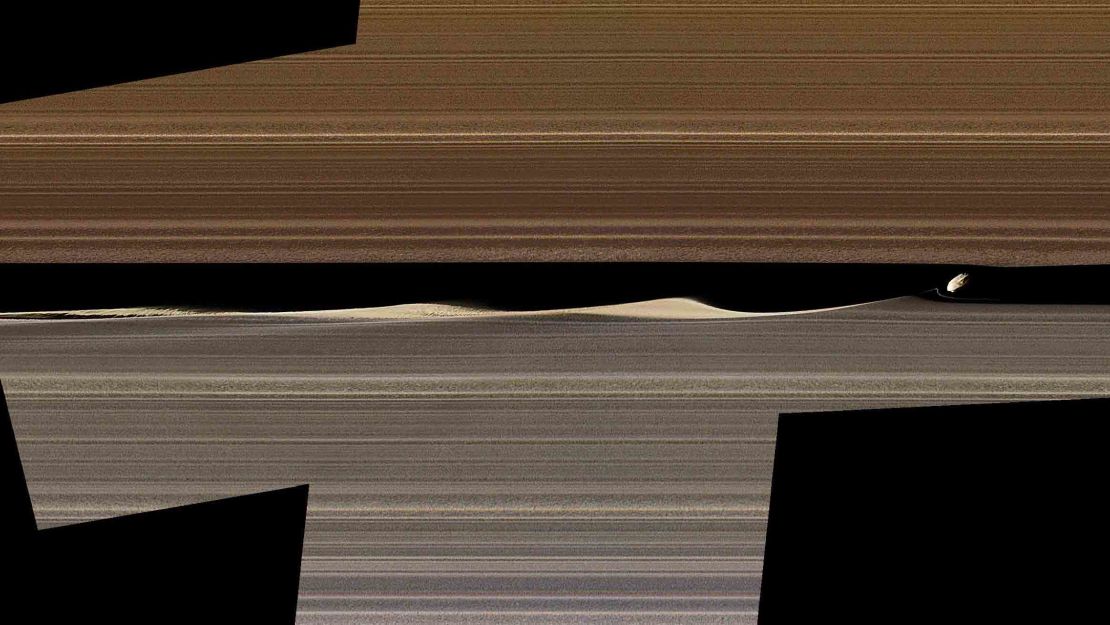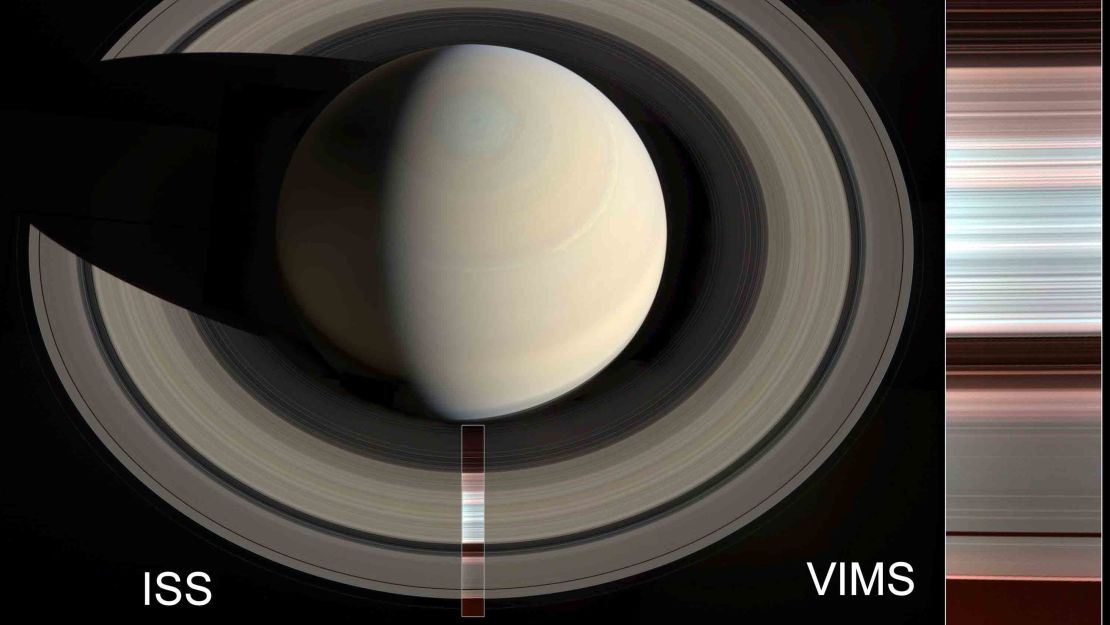During the final year of NASA’s Cassini mission before it completed a “death dive” into Saturn’s atmosphere in 2017, the spacecraft gathered as much data as possible about the planet’s rings.
The instruments aboard Cassini were able to take the closest observations of the main rings. An analysis of the ring data was published Thursday in the journal Science.
The analysis helped scientists create new maps of the rings that show how chemistry, temperature and colors change from ring to ring.
And although they appear smooth and seamless from a distance, up close, it’s clear that there are different structures within the rings. Textures and patterns emerge. Some of them look like straw; others are filled with clumps. Different processes have shaped them.
Some of those processes include Saturn’s tiny moons, embedded in the rings, interacting with the particles around them.
In the outer F ring, a series of streaks seems to have been caused by the same impacts due to their similar length and direction. This ring in particular is shaped by materials that orbit Saturn, as opposed to debris that crashes into the rings.
“These new details of how the moons are sculpting the rings in various ways provide a window into solar system formation, where you also have disks evolving under the influence of masses embedded within them,” said Matt Tiscareno, lead study author and Cassini scientist at the SETI Institute, in a statement.
There are boundaries around the distinct textures, possibly hinting at the composition of the rings and the purpose those different types of particles serve.

“This tells us the way the rings look is not just a function of how much material there is,” Tiscareno said. “There has to be something different about the characteristics of the particles, perhaps affecting what happens when two ring particles collide and bounce off each other. And we don’t yet know what it is.”
The A ring was discovered to have weak bands of water ice. This area is highly reflective, so it was thought that the bands would be stronger and less contaminated.
Scientists had found that water ice was the main component of the rings, but the new analysis ruled out the presence of ammonia and methane ice, as well as organic compounds. This is surprising because organic material was seen falling from the D ring into Saturn’s atmosphere during the Cassini mission.
“If organics were there in large amounts – at least in the main A, B and C rings – we’d see them,” said Phil Nicholson, study author and Cassini scientist at Cornell University, in a statement. “I’m not convinced yet that they are a major component of the main rings.”
During its final plunge, Cassini’s Ion and Neutral Mass Spectrometer acted as the “nose” of the spacecraft, directly sampling the composition and structure of the atmosphere. It’s something that can’t be done from orbit, said Hunter Waite, principal investigator on the spectrometer.
The move was done in hopes of investigating the “ring rain” phenomenon discovered by NASA’s Voyager mission in the early 1980s, in which it appeared that the rings were raining material onto the planet and causing changes in the atmosphere. The spectrometer could determine what material is from the rings and what is part of the atmosphere.
According to the spectrometer team, Cassini’s nose hit the “jackpot” as it sniffed out the unknown region between the planet and its closest rings. This is key because Saturn’s upper atmosphere extends almost to the rings.
In a 2018 study, researchers determined that complex organic compounds are raining a chemical cocktail of dust grains from the closest ring, D, into the upper atmosphere. The spectrometer revealed the rings to be composed of water, methane, ammonia, carbon monoxide, molecular nitrogen and carbon dioxide.

“Turns out, ring rain is more like a ring downpour,” Waite said. “While [the spectrometer] was designed to investigate gases, we were able to measure the ring particles because they hit the spacecraft at such high velocities they vaporized. Water ice, along with the newly discovered organic compounds, is falling out of the rings way faster than anyone thought – as much as 10,000 kilograms of material per second.”
Water ice was expected, but the other organics were not.
“Molecular hydrogen was, as expected, the most abundant atmospheric constituent,” said Kelly Miller, study co-author and Southwest Research Institute scientist. “But the downpour coming from the rings included plenty of water as well as molecules like butane and propane – the kind of chemicals you might use for a grill or camping stove.”
So much data was gathered during the Cassini mission that the quest for answers only continues. Years worth of research and studies are yet to come.
“We see so much more, and closer up, and we’re getting new and more interesting puzzles,” said Jeff Cuzzi, study author and interdisciplinary scientists for Cassini studying the rings. “We are just settling into the next phase, which is building new, detailed models of ring evolution – including the new revelation from Cassini data that the rings are much younger than Saturn.”
Although the answers to many questions about Saturn have been answered by Cassini’s data, new questions and mysteries have emerged from the mission.
“It’s like turning the power up one more notch on what we could see in the rings. Everyone just got a clearer view of what’s going on,” said Linda Spilker, study author and Cassini Project scientist. “Getting that extra resolution answered many questions, but so many tantalizing ones remain.”






















